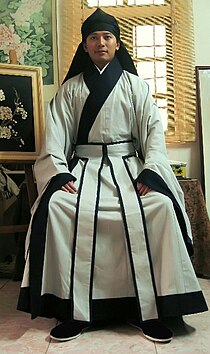Shenyi

Shenyi (Chinese: 深衣; Wade–Giles: Shên-i; Korean: 심의; Hanja: 深衣; RR: simui) (also known as "deep garment"[1][2] in English) literally means "wrapping the body deep within the clothes"[1] or "to wrap the body deep within cloth".[2]
It is the historical Chinese attire which is recorded in Book of Rites and advocated in Zhu Xi's Common Rites.[3] It was developed in Zhou Dynasty.[4][5] It became a form of formal wear for the scholar-official in Song Dynasty and Ming Dynasty.[6] It was also introduced to Korea and Japan and exerted influences on Confucian clothing of Korea and Japan. The scholar-dress Shenyi was introduced to Korea during Goryeo dynasty, and it was worn by followers of Confucianism.[7]
History[]
Zhou dynasty[]
The shenyi was the dominant form of Chinese dress worn from the Zhou dynasty to the Han dynasty.[4][5] The shenyi is a one-piece style which was first developed in the Warring States Period and was further developed into the Han Dynasty robe.[1] It is the combination of the upper garment and a skirt sewn together.[8]
At that period, the style of clothing was deeply rooted in the traditional Chinese ethics and morals which forbid close contacts between males and females.[1] In the Book of Rites (also known as Liji), there is a special chapter which details the making of the shenyi,[1][9] which stipulates that the shenyi is "one long robe; that it have broad sleeve openings; that its circumference at the waist be three times that of the sleeve-opening and that of its hem be even larger; that it have a youren opening".[10] The shenyi is also tied right below the waist with a silk ribbon, called dadai or shendai, on which a decorative piece can be attached to.[1] Twelve robes excavated from a Mashan tomb belonging to an anonymous lady who died sometime between 340–278 B.C. were all cut in the approximate style of shenyi whether they were padded with silk floss (mianpao), single in layer (danyi) or lined (jiayi).[10]

A tomb figurine representing an attentant, wearing a shenyi of its period, Warring States Period (475–221 BC), Shanghai Museum.
Qin to Han dynasties[]
The shenyi grew in popularity during the transition from the Warring States period to the Former Han dynasty and its shape deviated further from its earlier description.[10] In the Han dynasty, the shenyi had wide sleeves and evolved into two types of robe: the qujupao (also known as "curved gown") and the zhijupao (also known as chan or yu or chanyu (Chinese: 襜褕), "straight gown" in English).[1]
The qujupao (Chinese: 曲裾袍) was a cross-collared long robe, long enough to cover the ankles; its right front piece was cut as a triangular front piece that crossed in front of the body and has rounded under hem.[1][11][12] The qujupao's collar was deliberately made low so that layers of the undergarments could be exposed.[13] The qujupao would curve and wraps the dress to the back[10] and the contrasting or decorative edging of the robe would create a spiralling effect when encircling the body,[12] while the front opening of the Zhijupao (Chinese: 直裾袍) would fall straight down.[10]
Although the Zhijupao was popular in the Han dynasty, it was not allowed to be worn as a ceremonial wear, for wearing outside of the house or for receiving guests at home.[1] When trousers with crotches started to be worn, replacing the trousers without crotches, the shorter-version of Zhijupao replaced the qujupao.[14] Examples of shenyi worn in the Han dynasty can be seen in the archeological artefacts excavated from Mawangdui tomb in museums.[4][15][5][16] Of note, there have been gradual changes but clear distinctions in the form of the shenyi between the early and late period of the Western Han dynasty.[12] For example, the quju-style shenyi became nearly obsolete by the middle of the Western Han dynasty; and by the late Western Han dynasty, the garments were straight rather than spiralled.[12] In the Eastern Han dynasty, very few people wore shenyi.[17] The shenyi lost popularity in the later dynasties until it was revived again the Song dynasty.[16][18]

Fresco of two Men from a Han Dynasty Tomb in Sian, Shensi

Men and women dressing the Han dynasty shenyi, mural from late Western Han dynasty (202 BC – 9 AD) or Xin dynasty era (9–25 AD) in Dongoing County.

Terracotta army statue, Qin dynasty
A kneeling lady in Zhijupao, Western Han. The layers of clothing are designed to show the multiple layers of garments worn.

Mawangdui Han Gown

Mawangdui Han Gown

Maid figurine wearing qujupao, Mawangdui Han Tombs, Changsha, Hunan.
Later development (Song to Ming dynasties)[]
In the Song dynasty, Neo-Confucian philosophies determined the conduct code of the scholars.[19] The Neo-Confucians re-constructed the meaning of the shenyi, restored, and re-invented it as the attire of the Neo-Confucian scholars in order to distinguish themselves from other scholars who came from school of thoughts.[16] Some Song dynasty scholars, such as Sima Guang and Zhu Xi, made their own version of the scholar gown based on The book of Rites, while other scholars such as Jin Lüxiang promoted it among his peers.[18] However, the shenyi used as a scholar gown was not popular in the Song dynasty and was even considered as "strange garment" despite some scholar-officials appreciated it.[16][18]

Song Confucian scholar Su Shi
In the Ming dynasty, in line with the attempt of the Hongwu Emperor to replace all the foreign clothing used by the Mongols of Yuan, and the support of the Chinese elites, the shenyi rose in popularity.[16] It became a symbol of status and Han ethnicity (as it was devoid of all foreign influence); the shenyi also denoted Chinese intellectual pride and superiority.[16] In Ming, it was widely worn by scholars and officials.[16]

Ming man wearing shenyi

Ming man wearing shenyi.

Ming dynasty man wearing shenyi

Ming dynasty Shenyi.
Design[]
Shenyi in later dynasties directly descended from the shenyi worn in earlier dynasties, like Han Dynasty. Shenyi originally is made of ramie cultivated in China. Ramie fabric needs to be bleached and produced 45 to 60 centimeters wide textile.
Similarly to the shenyi worn from Zhou to Han dynasties, the shenyi designed in Song dynasty followed the same principles. The yi (衣, blouse) and chang (裳, skirt) of the shenyi is sewn together.[1][18] The upper part is made up of 4 panels of ramie fabric, representing four seasons of a year. 2 panels are fold and sewn to cover the upper body. Another 2 panels of ramie fabric are sewn onto each side of the yi as two sleeves. The lower part is made up of 12 panels of fabric sewn together (十二片縫��), representing 12 months a year.[9] Its sleeves are wide with black cuff. A wide sash (大帶) is tied in the front.[1][9] In the Song dynasty, the shenyi was made with white fabric.[18] The shenyi is also tied right below the waist with a silk ribbon, called dadai (大带) or shendai (绅带), on which a decorative piece can be attached to.[1]

Structure of shenyi


Illustration of dadai belt, from the Chinese encyclopedia Gujin Tushu Jicheng, section "Ceremonial Usages".
Qujupao[]
Zhijupao[]
Korean version[]
In Korea, the shenyi is called simui (Korean: 심의; Hanja: 深衣).[7][20] The simui was worn as an outer garment by the seonbi.[21] The seonbi in Joseon imitated the clothing attire designed by Zhu Xi, i.e. the shenyi and the literati hat.[22] The seonbi, who valued the simui greatly, embraced it as a symbol of Confucian civilization, and continued to publish treatise on the simui starting from the sixteenth century AD.[16]
The simui is white and in terms of design, it has wide sleeves and is composed on an upper and lower part which is attached together (衣裳連衣; Uisangyeonui) at the waistline; the lower part has 12 panels which represents 12 months.[20][21] It is a high-waist robe and a belt (大帶; dadae) is tied to the simui.[20][21]

Korean Confucian scholar

Korean Confucian scholar Yun Jeung

Korean Confucian scholar Yi Je-hyun

Korean Confucian scholar Song Siyeol

Korean Confucian scholar Park Ji-won

Korean Confucian scholar Kwon Sang-ha

Korean Confucian scholar Heo Mok

Korean Confucian scholar Kim Jong-jik

Korean Confucian scholar Han Seok-bong
Japanese version[]
The early Tokugawa period Japan, some Japanese scholars, such as Seika Fujiwara and Hayashi Razan, who self-proclaimed themselves as followers of Zhu Xi wore the shenyi and gave lectures in it.[16]

Japanese Confucian scholar Fujiwara Seika

Edo Confucian scholar Hayashi Razan
Vietnamese version[]
In the Le dynasty, there were some ancient statues left behind, showing Confucian scholars wearing shenyi. But shenyi was not only worn by Confucian scholars; it was also commoners. Until the Nguyen dynasty, shenyi was still seen in a number of photos.

Vietnamese Confucian scholar Vũ Miên

Le dynasty man wearing shenyi

Le dynasty man wearing shenyi
See also[]
- Diyi – a form of shenyi worn as Ceremonial clothing for women
- Hanfu
- List of Hanfu
- Panling lanshan
- Paofu
References[]
- ^ a b c d e f g h i j k l Hua, Mei (2004). Chinese Clothing (1 ed.). Beijing: China International Press. pp. 9–14. ISBN 7-5085-0540-9.
- ^ a b Lynch, Annette; Strauss, Mitchel D. (2014). Ethnic dress in the United States : a cultural encyclopedia. Lanham, Maryland: Rowman & Littlefield Publishers. pp. 135–136. ISBN 9780759121508. Retrieved 3 February 2021.
- ^ 《朱子家禮》
- ^ a b c Hunan Museum. "Plain Gauze Gown". Hunan Museum. Retrieved 3 February 2021.
- ^ a b c Zhang, Qizhi (2015). An introduction to Chinese history and culture. Heidelberg: Springer, Berlin, Heidelberg. pp. 255–261. ISBN 978-3-662-46482-3.
- ^ Wang, Chen (2014-09-01). "Conservation study of Ming dynasty silk costumes excavated in Jiangsu region, China". Studies in Conservation. 59 (sup1): S177–S180. doi:10.1179/204705814X13975704319154. ISSN 0039-3630. S2CID 191384101.
- ^ a b "심의(深衣)". Encyclopedia of Korean Culture.
- ^ Lüsted, Marcia Amidon (2017). Ancient Chinese daily life (1 ed.). New York: New York : Rosen Publishing. pp. 14–22. ISBN 978-1-4777-8889-9. OCLC 957525459.
- ^ a b c "Liji : Shen Yi - Chinese Text Project". ctext.org. Retrieved 2021-02-07.
- ^ a b c d e Sheng, Angela (1995). "The Disappearance of Silk Weaves with Weft Effects in Early China". Chinese Science (12): 41–76. ISSN 0361-9001. JSTOR 43290485. Retrieved 3 February 2021.
- ^ Zang, Yingchun; 臧迎春. (2003). Zhongguo chuan tong fu shi. 李竹润., 王德华., 顾映晨. (Di 1 ban ed.). Beijing: Wu zhou chuan bo chu ban she. ISBN 7-5085-0279-5. OCLC 55895164.
- ^ a b c d Lullo, Sheri A. (September 2019). "Trailing Locks and Flowing Robes: Dimensions of Beauty during China's Han dynasty (206 bc – ad 220)". Costume. 53 (2): 231–255. doi:10.3366/cost.2019.0122. Retrieved 3 February 2021.
- ^ Zang, Yingchun; 臧迎春. (2003). Zhongguo chuan tong fu shi. 李竹润., 王德华., 顾映晨. (Di 1 ban ed.). Beijing: Wu zhou chuan bo chu ban she. ISBN 7-5085-0279-5. OCLC 55895164.
- ^ Zang, Yingchun; 臧迎春. (2003). Zhongguo chuan tong fu shi. 李竹润., 王德华., 顾映晨. (Di 1 ban ed.). Beijing: Wu zhou chuan bo chu ban she. ISBN 7-5085-0279-5. OCLC 55895164.
- ^ Hong Kong Heritage Museum. "Images of Females in Chinese History: Thematic Gallery". Hong Kong Heritage Museum. Retrieved 3 February 2021.
- ^ a b c d e f g h i Hu, Minghui (2016). "The Scholar's Robe: Material Culture and Political Power in Early Modern China". Frontiers of History in China. 11 (3): 339–375. doi:10.3868/s020-005-016-0020-4. ISSN 1673-3401.
- ^ "Costume in the Han Dynasty - - China Style". www.chinastyle.cn. Retrieved 2021-02-06.
- ^ a b c d e Zhu, Ruixi; 朱瑞熙 (2016). A social history of middle-period China : the Song, Liao, Western Xia and Jin dynasties. Bangwei Zhang, Fusheng Liu, Chongbang Cai, Zengyu Wang, Peter Ditmanson, Bang Qian Zhu. Cambridge, United Kingdom: Cambridge University Press. p. 15. ISBN 978-1-107-16786-5. OCLC 953576345.
- ^ Xu, Guobin; Chen, Yanhui; Xu, Lianhua (2018), Xu, Guobin; Chen, Yanhui; Xu, Lianhua (eds.), "Clothing, Food, Housing and Transportation", Introduction to Chinese Culture: Cultural History, Arts, Festivals and Rituals, Singapore: Springer, pp. 181–203, doi:10.1007/978-981-10-8156-9_8, ISBN 978-981-10-8156-9, retrieved 2021-02-14
- ^ a b c Nam, Min-yi; Han, Myung-Sook (2000). "A Study on the Items and Shapes of Korean Shrouds". The International Journal of Costume Culture. 3 (2): 100–123.
- ^ a b c Lee, Samuel Songhoon (2013). Hanbok : Timeless fashion tradition. Seoul: Seoul, Korea : Seoul Selection. pp. 58–59. ISBN 978-89-97639-41-0. OCLC 871061483.
- ^ Yunesŭk'o Han'guk Wiwŏnhoe (2005). Korea Journal. 45. Korean National Commission for UNESCO. p. 125.
- Chinese traditional clothing
- Clothing stubs
- China stubs





































